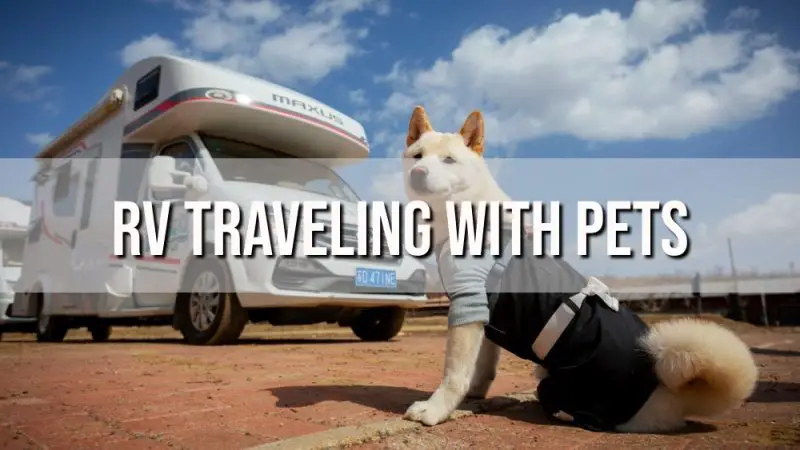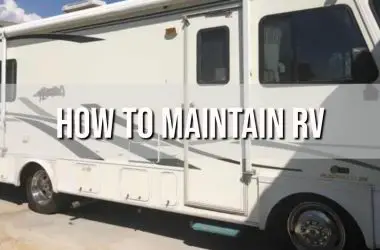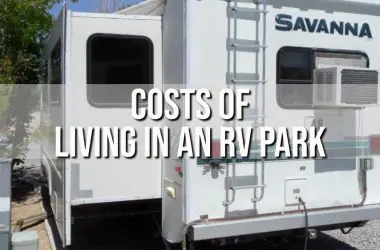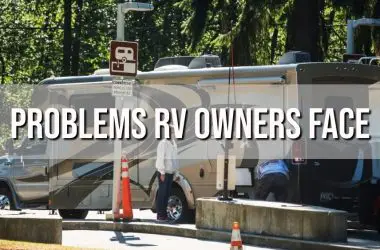Whether it’s hitting the open road or camping in nature, RVing allows pet owners to bring their furry companions on adventures. But RV traveling with pets comes with its own unique considerations. Proper planning and preparation are key to ensure a smooth and safe RV trip with pets. This comprehensive guide covers everything you need to know – from choosing the right RV to packing essentials and overcoming challenges on the road. Follow these RVing with pets tips to make your next motorhome journey with animals stress-free and fun for the whole family.
Key Takeaways
- Choose an RV with adequate space and safety features to accommodate pets comfortably. Factor in size, layout, and ventilation.
- Prepare pets for travel by visiting the vet, training them, and familiarizing them with the RV ahead of time.
- Pack ample pet food, medications, comfy beds, toys, leashes, litter boxes, and first aid kits.
- Research campground pet policies. Follow rules and keep pets leashed and supervised outdoors.
- Maintain health with regular exercise, proper nutrition, and motion sickness prevention. Identify nearby vets.
- Manage anxiety with familiar smells, frequent stops, and safety harnesses in the RV. Clean accidents immediately.
Understanding the Basics of RVing with Pets
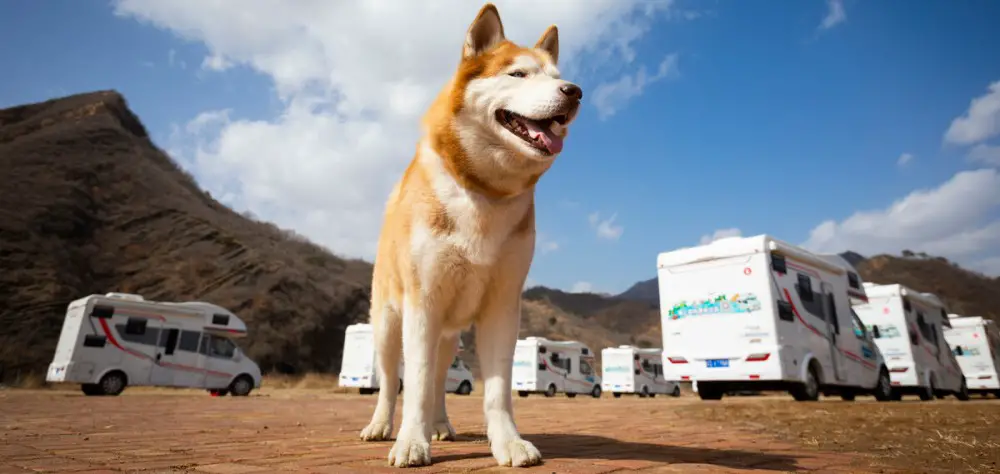
Hitting the open highways in a recreational vehicle allows you to bring beloved pets along for the ride. RVing with pets lets you explore beautiful destinations together and bond even more during the journey. But traveling with animals requires extra planning and preparation compared to a normal family road trip.
When RVing with pets, you’ll need to factor in their needs every step of the way. Choosing the right motorhome, prep work before departure, packing essentials, maintaining health, and overcoming challenges will be important. With the proper diligence and care, RVing with pets can be an amazing experience for all.
Certain RV features and accessories will make the trip easier on animal companions. You’ll also need to familiarize pets with RV travel well in advance, as this will be a very new and different environment for them. It’s crucial to pack the right supplies to keep pets happy and healthy on the road.
Researching campground regulations is also a must, as many have restrictions on the number, size or type of pets. Maintaining a consistent routine and providing anxiety relief will make travel less stressful for pets. By staying on top of their needs, you can avoid unpleasant surprises and keep the focus on fun and quality time together. With the right RVing with pets pointers in mind, you’ll be ready to hit the road for an amazing trip.

Choosing the Right RV for Your Pet
Selecting an RV well-suited for travel with pets is a key first step. Certain features will allow your furry friends to ride safely and comfortably. Consider the following factors when choosing an RV for animals:
Size and Layout Considerations
Look for floor plans with enough space for multiple pets to move about freely. Bigger RVs like Class A motorhomes or 5th wheels allow more room versus smaller camper trailers. Consider your specific pet sizes and quantities when deciding on RV length. Measure dogs at shoulder height and choose an RV ceiling height that accommodates their full height.
Look for floorplans that provide separation between living and cargo areas. Slide outs, dividers, and partitions allow pets their own designated space for crates, litter boxes and beds. Make sure ceiling vents run the AC into the pet area. Check that windows open wide enough for sufficient ventilation too.
Pick an RV with easy access doors on both sides so pets can enter and exit easily for potty breaks. Look for easy-clean surfaces and floors in case of accidents. Hard floors are ideal over carpeting.
Safety Features
Choose an RV with solid, well-secured cabinet doors and drawers. Look for sturdy latches that will stay closed, preventing pets from nosing their way into unsafe areas.
Make sure vents and openings are properly sealed so paws and snouts don’t get hurt or stuck. Cover all exposed pipes and wires pets could chew on when bored.
Select an RV with plenty of tie-down hooks to secure crates, cages, food bowls and litter boxes safely. Items sliding around can injure traveling pets. Rubber mats also provide traction for pets and secure bowls in place.
Provide visibility for pets by choosing an RV with window views at their eye level. Pets will enjoy taking in the passing sights and sounds. Monitor driving safely via mirrors adjusted for blind spots and install supplemental side and rear pet cameras.
Ventilation
Proper ventilation is crucial when RVing with pets, so look for plenty of windows, roof vents and fans. Good airflow prevents dangerous buildup of odors and fumes from litter boxes, food or gas appliances.
Install vent covers, screens and filters to keep fresh air circulating while blocking debris and pests. Choose pet beds and crates made of breathable fabrics and materials.
Powerful roof air conditioners and generators will maintain a comfortable temperature in an RV full of warm pet bodies. Double check that vents direct cool air into the pet area.
Waste Management
Plan for proper pet waste management by choosing an RV with external storage areas, drains and tanks. Built in plumbing systems designed to handle “black water” make emptying litter boxes easy.
Look for pet friendly flooring that contains accidents and is easy to clean and disinfect. Avoid absorbent carpets in favor of vinyl, laminate or linoleum floors.

Preparing Your Pet for RV Travel
The key to an enjoyable RV trip with pets is preparing them fully for the experience. Here are some tips to get your furry friends road trip ready:
Health Checkups
Schedule a full veterinary exam ahead of travel to ensure your pet is fit for the journey. Update all vaccines and boosters, deworming and flea/tick prevention. Make sure medications are refilled with extra supply. Have the vet document all medications with instructions in case you need to visit an emergency vet on the road.
Discuss motion sickness prevention and treatment plans. Obtain written proof of rabies vaccinations and health certificates if visiting parks or crossing state lines. Microchip pets and ensure chip registration is current so they can be identified if lost.
Behavioral Training
Gradually increase walks, runs, play time and trips in the car to build pet stamina for long days on the road.
Train pets to become comfortable wearing harnesses and riding calmly in crates secured in vehicles. Use treats and toys to positively reinforce good behavior during training sessions.
Work on commands like “sit”, “stay”, “kennel up” and “settle”. Teach cues like “ride time” to help pets know when to get in carriers. Use verbal praise and rewards to cement training.
Familiarizing with the RV
Allow pets to thoroughly explore the RV well before departure day. Let them sniff around and get used to the new space. Take short practice drives and reward calm behavior.
Use the same pet beds in the RV as you do at home so the comforting smells help relieve anxiety. Place water bowls and litter boxes in the same spots as home.
Run the RV systems like generator, heater, AC and appliances to desensitize pets to noises before trips. Expose pets to the lighting at different times of day so flashes or reflections don’t startle them later.
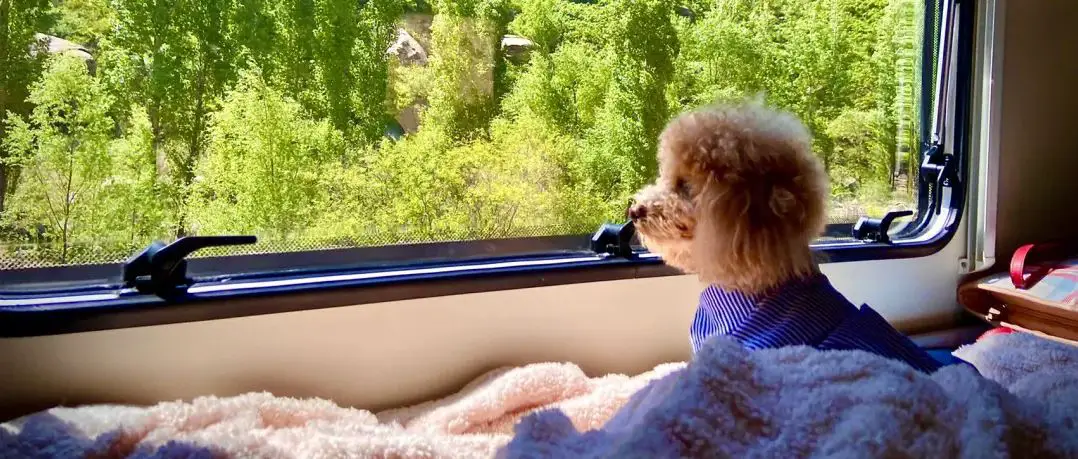
Essential Items to Pack for Your Pet
Proper pet gear will keep your furry friends happy, healthy and safe on the road. Here are some RVing with pets must-haves:
Food and Water Supplies
Pack at least a week’s worth of regular pet food, plus extra just in case. Bring wet and dry varieties if you normally feed both. Verify food brands/types available at planned stop points. Mark pet dietary restrictions clearly so others don’t accidentally feed the wrong thing.
Pack collapsible/travel water bowls. Use no-spill bowls with rubber bases or bowls that attach inside crates. Always restrain and secure bowls while driving to avoid spills.
Make sure to bring enough cat litter and box liners for the whole trip. Use clumping litter to make waste disposal easier. Place litter boxes in easy-access spots.
Comfort Items
Pack familiar beds, blankets and toys with comforting smells. Bring each pet’s favored security items to help relieve stress.
Use tent-like enclosures or covered crates to create a quiet, den-like retreat space. Use straps, cargo bars and removable adhesive hooks to securely fasten enclosures in place.
Plush beds with bolstered sides provide cozy nesting spots for pets. Attach slip-proof rug backings to beds to keep them from sliding around on floors.
Safety and Emergency Gear
Pack sturdy collars or harnesses and leashes for each pet to use during pit stops. Attach secondary IDs to collars in case primary tags fall off. Print temporary lost pet signs to post if needed.
Bring pet first aid kits. Include bandages, tweezers, thermometers, oral syringes, latex gloves, scissors, lubricating jelly and antiseptic wipes.
Pack cooling pads, portable fans, shade screens, and extra water to prevent heat exhaustion on hot days. Prepare jackets, blankets and booties for cold temperatures.
Keep copies of all veterinary and vaccine records, prescriptions, and proof of ownership documents in your RV emergency folder. Include contact info for regular and emergency veterinary clinics across your route.

Navigating Campgrounds and Parks with Pets
One of the major advantages of RVing is the ability to bring beloved pets on trips. But it’s important to research the regulations at each campground, RV park and destination. Here are some tips for navigating RV sites with pets:
Understanding Pet Policies
Determine maximum number, size and type of pets allowed per site, as well as any breed restrictions. Many limit 2 medium-sized pets per rig.
Clarify leash laws and designated relief areas. Leaving pets unattended tied outside is often prohibited.
Ask about pet deposits or fees per stay or per pet. These vary significantly by property.
Look for sites with amenities like dog parks, trails, wash stations and disposal bins. Avoid higher pet fees on premium lakefront or pool access sites you won’t fully utilize.
Book pet friendly off-season dates when fewer families vacation with loud, energetic kids that may frighten anxious pets.
Outdoor Safety
Keep dogs leashed whenever outside of your RV. Make sure tags include current cell phone and campsite info. Use longer 20-30 foot leash lengths for exploring trails while maintaining control over your pet.
Avoid other guests’ sites, play areas and common facilities like pools, gyms, game rooms, etc. These are off limits to pets.
Scope out safe grassy areas to walk your dog away from roadways and crowded central campground areas. Pick up all waste immediately and dispose of properly.
Keep cats/small pets in cages or enclosed playpens outside your RV for fresh air. Never let them roam around the campground freely.
Watch for environmental hazards like snakes, scorpions, spiders, bees, lakes, cacti etc. that could injure curious pets if they get too close.

Maintaining Your Pet’s Health on the Road
While the freedom of RVing is great fun for pets, certain aspects of travel can impact their health. Here are some tips for keeping your furry friends healthy on the go:
Regular Exercise
Make frequent stops to walk dogs several times per day. Use long leash lengths so they can run and play. Carry poop bags and self-sealing disposal bins.
Set up enclosed outdoor pen areas at each site to allow cats, birds or small pets fresh air and play time. Use tie downs to secure enclosures against wind gusts. Monitor closely.
Play interactive games using favorite toys inside the RV during downtime between destinations. Laser pointers and wand toys engage cats. Fetch keeps dogs active.
Proper Nutrition
Bring familiar foods pets are accustomed to and avoid sudden changes while traveling. Gradually transition onto local brands if needed.
Feed pets at customary meal times each day to maintain schedule. Ensure fresh water is available 24/7. Bring bottled for backup if unsure of campsite water sources.
Watch closely for decreased appetite, vomiting or changes in stool as possible signs of motion sickness or anxiety. Adjust driving times and anti-nausea medication dosages.
Avoid unhealthy people food, especially fatty scraps. The novelty can upset digestive systems.
Dealing with Sickness
Note any unusual coughing, nose discharge or fatigued panting as these may indicate illness or infection. Check for injuries, limping, lumps or skin irritations. Monitor for itchy ears, fleas, ticks or irritated paws.
Research vet clinics along your route in case immediate medical attention is required. Have records and authorization forms handy to share with vets easily.
Administer any regular medications as prescribed. Use motion sickness aids like pills, patches or calming chews to ease nausea during drive days.
Limit food and water intake if vomiting persists. Try bland boiled chicken and rice or the BRAT diet (banana, rice, applesauce, toast).
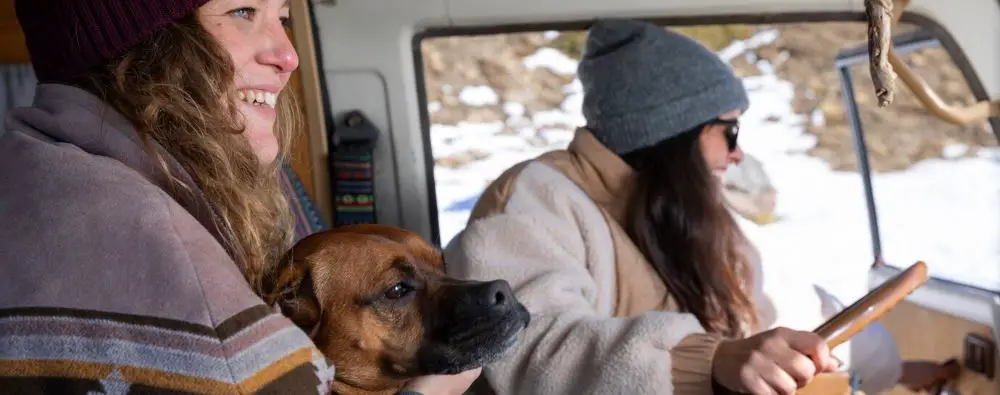
Overcoming Common Challenges of RVing with Pets
Despite meticulous preparation, there will likely be some bumps in the road when RVing with companion animals. Here are some tips for overcoming common challenges:
Managing Anxiety
Help high-anxiety pets relax by diffusing calming scents like lavender or chamomile and playing soothing music. Try anti-anxiety vests and rescue remedy. Use happy talk and keep attitudes upbeat despite outbursts.
Provide familiar smells with old bedding and worn T-shirts. Give special “security” toys and plenty of affection. Keep crates covered and encourage safe den-like areas.
Allow anxious pets to ride in passenger seats if they prefer. Pull over for frequent exercise and potty breaks to relieve stress. Adjust driving schedules to pets’ tolerance levels if needed.
Dealing with Accidents
Pack plenty of paper towels, cleaners, trash bags and stain/odor removers for accident cleanup. Use black lights to identify all soiled spots fully.
Confine unsupervised pets to easy-clean areas using pet gates. Place waterproof liners under crates. Potty train dogs to go on grass pads, fake turf mats or litter boxes if needed.
Respond calmly without scolding if accidents occur. Clean soiled areas immediately to avoid lingering odors or urine damage. Identify and address root causes of issues.
Conclusion of RV Traveling with Pets
RVing opens up a whole world of adventure you and beloved pets can enjoy together. By choosing the optimal rig, preparing fully, packing proper provisions, maintaining health, and dealing with challenges, your motorhome trip with animals can be memorable for all the right reasons. Focus on safety, organization and preventing unnecessary stress. Be patient and keep a schedule that suits your pets. Protect your pets and they’ll reward you with their trust, affection and company for the journey ahead. Most importantly, relax and soak up all the special moments RVing with pets allows.
Frequently Asked Questions
What are some tips for RVing with large dogs?
- Choose a Class A RV or 5th wheel with higher ceilings to accommodate tall dogs.
- Look for floorplans with a doggy door or easy access in and out.
- Bring comfy dog beds and mats to provide cushioning for large breeds.
- Use no-slip harnesses attached to seat belts or special anchors to secure large dogs safely.
- Pack a ramp or pet stairs to help big dogs climb in and out easily.
- Make plenty of stops so large dogs can stretch legs and exercise.
Which RVs are best for traveling with pets?
- Class C RVs provide interior space for pets without a huge price tag.
- Fifth wheel trailers tend to have roomy interiors to accommodate animals.
- Class A motorhomes offer the most spacious floorplans and storage for multi-pet families.
- Toy hauler trailers provide climate controlled garages for pets to ride in safely.
- Pop-up campers work best for smaller pets due to limited interior space.
How can I keep my pet cool in an RV?
- Run the A/C, ventilate, use fans to improve air circulation around pets.
- Fill water bowls with ice cubes to keep water cool. Freeze wet towels for pets to lay on.
- Park the RV in shady spots. Use screens and reflectors in windows facing the sun.
- Never leave pets alone in a hot RV. Bring them indoors or set up shaded outdoor pens.
- Cool down overheated pets immediately with tepid water baths. Seek veterinary care if heat exhaustion occurs.
What are some ways to calm a dog while traveling in an RV?
- Use comfortable crates lined with familiar bedding and toys. Cover crates to block visual distractions.
- Play soothing music and diffuse calming lavender, chamomile or pheromone scents.
- Give antianxiety coats, vests or natural supplements if approved by your vet.
- Provide secure spots for dogs to look out windows at sights and sounds.
- Make frequent stops so dogs can exit vehicles and walk around on leash.
What should I pack for my pet when RVing?
- At least 1-2 weeks of regular food and medications
- Collapsible food/water bowls, poop bags
- Favorite toys, treats, beds for comfort
- First aid kit, cleaning supplies for accidents
- Vaccine records and vet contact information
- Leashes, harnesses, carriers secured safely
- Motion sickness aids if needed
Are there any dog-friendly RV parks or campgrounds?
Yes, many RV parks and campgrounds welcome pets, though restrictions and fees vary. Good Sam, RV Parky app and AllStays website help locate pet friendly RV sites across the U.S. National parks and forests have some dog-friendly campgrounds and shared spaces too. Always call ahead to verify pet rules and availability.


